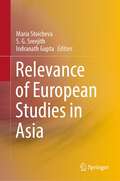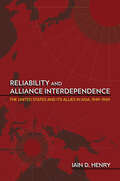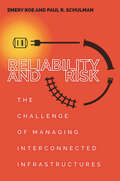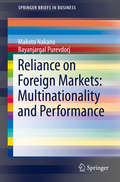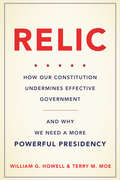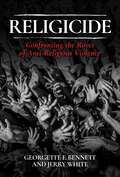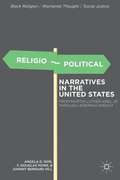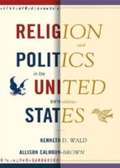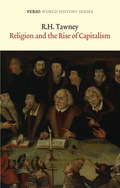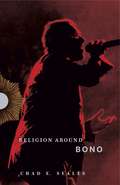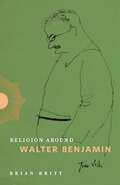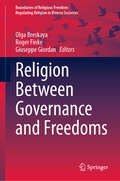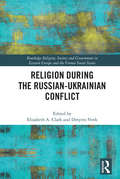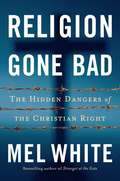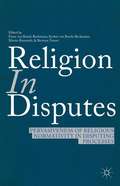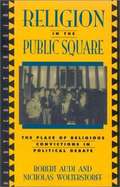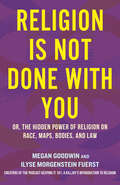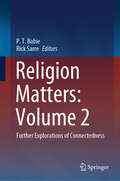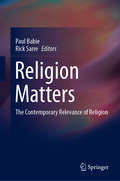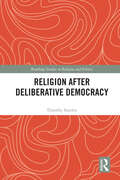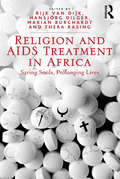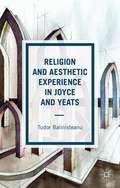- Table View
- List View
Relevance of Duties in the Contemporary World: With Special Emphasis on Gandhian Thought
by Kshitij Kumar Singh Raman MittalThis book reflects on the significance of duties in creating an egalitarian society by collating and contextualizing the relevant literature. It particularly focuses on an appreciation of Gandhi’s views on duty to showcase how they remain pertinent to create a cohesive, responsible and value-based society in the present right-dominated world. A viable solution to the current real world problems could be found in exploring the philosophy on duties and the book provides relevant literature in this regard. It undertakes jurisprudential analysis of duty in a rights-dominated world, identifying the gaps in realising the potential of duty to address the critical issues of the present times. It argues that enforcement of rights depends heavily on the observance of duties and proposes coherence in right-duty relationship. Gandhian thought on duty recognises duty as a precursor to rights and emphasises that the observance of duties guarantees the enforcement of rights. The relevance of duties and Gandhian thoughts on the same is not restricted to India but transcends borders with profound appeal. Gandhian thoughts have become even more relevant in the current times to examine the situation of COVID-19 pandemic, racial discrimination (BLM), environmental crises, digital divide, health care and medical care crises, refugee and migrant labour problems and it can offer promising solutions based on the nuances of social solidarity, self realisation of duties/responsibilities, local governance, compassion and humanity.
Relevance of European Studies in Asia
by Indranath Gupta Maria Stoicheva S. G. SreejithThis book provides perspectives on the relevance of European Studies as a disciplinary category for the Asian region. That being the primary focus, the book serves a larger purpose. First, it provides insights on European society, polity and economy (including European Integration) as they are accounted in European Studies. The epistemological character of the knowledge thus conveyed has larger credibility and reliability such that they can become policy inputs and imaginations for strengthening Asian-European relationship. This approach helps overcome the trap of subjectively motivated discourses on Europe which may fail potential collaborations between the regions. Second, the design and discursivity of European Studies will be an instruction to the Asian region on the constitutive potential of regional studies in society-building. Third, the book works towards building the idea of “Europe” in terms of international law, in the minds of Asian students, researchers and decision-makers. This is extremely relevant for the future relationship and cultural engagement between the two regions. The book is of interest to policymakers, academics, embassies, state-level government offices, researchers and students.
Reliability and Alliance Interdependence: The United States and Its Allies in Asia, 1949–1969 (Cornell Studies in Security Affairs)
by Iain D. HenryIn Reliability and Alliance Interdependence, Iain D. Henry argues for a more sophisticated approach to alliance politics and ideas of interdependence. It is often assumed that if the United States failed to defend an ally, then this disloyalty would instantly and irrevocably damage US alliances across the globe. Henry proposes that such damage is by no means inevitable and that predictions of disaster are dangerously simplistic. If other allies fear the risks of military escalation more than the consequences of the United States abandoning an ally, then they will welcome, encourage, and even praise such an instance of disloyalty. It is also often assumed that alliance interdependence only constrains US policy options, but Henry shows how the United States can manipulate interdependence to set an example of what constitutes acceptable allied behavior. Using declassified documents, Henry explores five case studies involving US alliances with South Korea, Japan, the Republic of China, the Philippines, Australia, and New Zealand. Reliability and Alliance Interdependence makes a substantial contribution to our understanding of how America's alliances in Asia function as an interdependent system.
Reliability and Risk: The Challenge of Managing Interconnected Infrastructures
by Emery Roe Paul SchulmanThe safe and continued functioning of critical infrastructures--such as electricity, natural gas, transportation, and water--is a social imperative. Yet the complex connections between these systems renders them increasingly precarious. Furthermore, though we depend so heavily on interconnected infrastructures, we do not fully understand the risks involved in their failure. Emery Roe and Paul R. Schulman argue that designs, policies, and laws often overlook the knowledge and experiences of those who manage these systems on the ground--reliability professionals who have vital insights that would be invaluable to planning. To combat this major blind spot, the athors construct a new theoretical perspective that reveals how to make sense of complex interconnected networks and improve reliability through management, regulation, and political leadership. To illustrate their approach in action, they present a multi-year case study of one of the world's most important "infrastructure crossroads," the San Francisco Bay-Delta. Reliability and Risk advances our understanding of what it takes to ensure the dependability of the intricate--and sometimes hazardous--systems on which we rely every day.
Reliability and Validity of International Large-Scale Assessment: Understanding IEA’s Comparative Studies of Student Achievement (IEA Research for Education #10)
by Hans WagemakerThis open access book describes and reviews the development of the quality control mechanisms and methodologies associated with IEA’s extensive program of educational research. A group of renowned international researchers, directly involved in the design and execution of IEA’s international large-scale assessments (ILSAs), describe the operational and quality control procedures that are employed to address the challenges associated with providing high-quality, comparable data. Throughout the now considerable history of IEA’s international large-scale assessments, establishing the quality of the data has been paramount. Research in the complex multinational context in which IEA studies operate imposes significant burdens and challenges in terms of the methodologies and technologies that have been developed to achieve the stated study goals. The demands of the twin imperatives of validity and reliability must be satisfied in the context of multiple and diverse cultures, languages, orthographies, educational structures, educational histories, and traditions. Readers will learn about IEA’s approach to such challenges, and the methods used to ensure that the quality of the data provided to policymakers and researchers can be trusted. An often neglected area of investigation, namely the consequential validity of ILSAs, is also explored, examining issues related to reporting, dissemination, and impact, including discussion of the limits of interpretation. The final chapters address the question of the influence of ILSAs on policy and reform in education, including a case study from Singapore, a country known for its outstanding levels of achievement, but which nevertheless seeks the means of continual improvement, illustrating best practice use of ILSA data.
Reliance on Foreign Markets: Multinationality and Performance
by Makoto Nakano Bayanjargal PurevdorjThis study examines the relationship between multinationality and the performance of Japanese manufacturing companies during the period 1999-2008 by using geographic segment information. Despite the enormous interest in and importance given to multinationality from the academic and business worlds, prior findings about the multinationality-performance relationship are conflicting and inconsistent. The overall results of the present study show that multinationality has a positive impact both on accounting performance and on market-based performance. In additional tests, Japanese electric and electronic equipment companies' reliance on the Asian market was found to have a negative impact on profitability and no significant impact on firm value, whereas reliance on other foreign markets such as the Americas and the EU had a positive impact on profitability and firm value. The multinationality-performance relationship cannot be generalized and varies among geographic regions. This book contributes to both the multinationality-performance literature and the geographic segment reporting literature by offering empirical evidence about Japanese manufacturing companies and comparing them with prior findings about American companies.
Relic: How Our Constitution Undermines Effective Government--and Why We Need a More Powerful Presidency
by William G. Howell Terry M. MoeOur government is failing us. From health care to immigration, from the deficit to climate change, our political institutions have long shown that they are incapable of meeting the challenges of modern society. Why the dysfunction? In Relic, William Howell and Terry Moe point to the Constitution as the main culprit. The framers designed a government for a simple, agrarian society-and that government is unsuited to a huge, complex, post-industrial nation the founders did not even remotely foresee. Howell and Moe argue that we need a second Progressive movement to bring reform to American government, above all by strengthening the power of the president. Relic challenges us to reconsider the very foundation of our political system, shedding new light on what is wrong with our government and what can be done about it.
Religicide: Confronting the Roots of Anti-Religious Violence
by Jerry White Georgette F. BennettA brave and timely proposal to name, investigate, and ultimately stop a new crime–the mass murder of millions of people for their faith.eligion-related violence is the fastest spreading type of violence worldwide. Attacks on religious minorities follow a clear pattern and are preceded with early warning signs. Until now, such violence had no name, let alone a set of policies designed to identify and prevent it. A unique attempt to create a new moral and legal category alongside other forms of persecution and mass murder, Religicide explores the roots of atrocities such as the Armenian Genocide, the Holocaust, the Bosnian war, and other human rights catastrophes. The authors tap into their decades of activism, interreligious engagement, and people-to-people diplomacy to delve into a gripping examination of contemporary religicides: the Yazidis in Iraq, the Rohingya in Myanmar, Uyghur Muslims and Tibetan Buddhists in China, and the centuries-long efforts to wipe out Indigenous Americans. Yet, even in the face of these horrific atrocities, the authors resist despair. They amplify the voices of survivors and offer a blueprint for action, calling on government, business, civil society, and religious leaders to join in a global campaign to protect religious minorities.
Religio-Political Narratives in the United States
by Angela D. Sims F. Douglas Powe Jr. Johnny Bernard HillThe authors select sermons by Martin Luther King Jr. and Jeremiah Wright to as a framework to examine the meaning of God in America as part of the formational religio-political narrative of the country.
Religion And Politics In The United States (6th Edition)
by Kenneth D. Wald Allison Calhoun-BrownReligion and Politics in the United States, Sixth Edition, offers a comprehensive account of the role of religious ideas, institutions and communities in American life. This book examines the ways religion can both compel and constrain involvement in politics and policy. What facilitates political participation? What impedes it? What are the limits of religious mobilization and involvement? Are there benefits? Are there dangers? Religion and Politics in the United States addresses these questions by exploring how religion has influenced the structure of American government and law as well as how religious perspectives inform contemporary political issues including topics such as equal rights for women and gays. The book also explores the ways that religion has affected the orientation of partisan politics in the United States. Through a detailed review of the political attitudes and behaviors of major religious and minority faith traditions, the book establishes that religion continues to be a major part of the American cultural and political milieu while explaining that it must interact with many other factors to impact political outcomes in the United States. The sixth edition reviews the role of religion in the 2008 election and includes coverage of how religion informs the civil rights struggles of women and gay Americans.
Religion And The Rise Of Capitalism
by R. H. TawneyIn one of the true classics of twentieth-century political economy, R. H. Tawney addresses the question of how religion has affected social and economic practices. He tracks the influence of religious thought on capitalist economy and ideology since the Middle Ages, shedding light on the question of why Christianity continues to exert a unique role in the marketplace. In so doing, the book offers an incisive analysis of the morals and mores of contemporary Western culture.Religion and the Rise of Capitalism is more pertinent now than ever, as today the dividing line between the spheres of religion and secular business is shifting, blending ethical considerations with the motivations of the marketplace. By examining the period that saw the transition from medieval to modern theories of social organization, Tawney clarifies the most pressing problems of the end of the century. In tough, muscular, richly varied prose, he tells an absorbing and meaningful story. And in his new introduction, which may well be a classic in its own right, Adam Seligman details Tawney's background and the current status of academic thought on these issues, and he provides a comparative analysis of Tawney with Max Weber that will at once delight and inform readers.From the Trade Paperback edition.
Religion Around Bono: Evangelical Enchantment and Neoliberal Capitalism (Religion Around #7)
by Chad E. SealesFor many, U2’s Bono is an icon of both evangelical spirituality and secular moral activism. In this book, Chad E. Seales examines the religious and spiritual culture that has built up around the rock star over the course of his career and considers how Bono engages with that religion in his music and in his activism.Looking at Bono and his work within a wider critique of white American evangelicalism, Seales traces Bono’s career, from his background in religious groups in the 1970s to his rise to stardom in the 1980s and his relationship with political and economic figures, such as Jeffrey Sachs, Bill Clinton, and Jesse Helms. In doing so, Seales shows us a different Bono, one who uses the spiritual meaning of church tradition to advocate for the promise that free markets and for-profits will bring justice and freedom to the world’s poor. Engaging with scholarship in popular culture, music, religious studies, race, and economic development, Seales makes the compelling case that neoliberal capitalism is a religion and that Bono is its best-known celebrity revivalist.Engagingly written and bitingly critical, Religion Around Bono promises to transform our understanding of the rock star’s career and advocacy. Those interested in the intersection of rock music, religion, and activism will find Seales’s study provocative and enlightening.
Religion Around Bono: Evangelical Enchantment and Neoliberal Capitalism (Religion Around)
by Chad E. SealesFor many, U2’s Bono is an icon of both evangelical spirituality and secular moral activism. In this book, Chad E. Seales examines the religious and spiritual culture that has built up around the rock star over the course of his career and considers how Bono engages with that religion in his music and in his activism.Looking at Bono and his work within a wider critique of white American evangelicalism, Seales traces Bono’s career, from his background in religious groups in the 1970s to his rise to stardom in the 1980s and his relationship with political and economic figures, such as Jeffrey Sachs, Bill Clinton, and Jesse Helms. In doing so, Seales shows us a different Bono, one who uses the spiritual meaning of church tradition to advocate for the promise that free markets and for-profits will bring justice and freedom to the world’s poor. Engaging with scholarship in popular culture, music, religious studies, race, and economic development, Seales makes the compelling case that neoliberal capitalism is a religion and that Bono is its best-known celebrity revivalist.Engagingly written and bitingly critical, Religion Around Bono promises to transform our understanding of the rock star’s career and advocacy. Those interested in the intersection of rock music, religion, and activism will find Seales’s study provocative and enlightening.
Religion Around Walter Benjamin (Religion Around)
by Brian BrittThis book shows how institutional religion and the religiosity of political and cultural life provide a necessary dimension to Walter Benjamin, one of the twentieth century’s greatest thinkers. Lived religion surrounded Benjamin, whose upper-middle-class Jewish family celebrated Christmas and Hanukkah in Berlin as the turmoil of war, collapsing empires, and modern urban life gave rise to the Nazi regime that would destroy most of Europe’s Jews, including Benjamin himself. Documenting the vitality and diversity of religious life that surrounded Benjamin in Germany, France, and beyond, Brian Britt shows the extent to which religious communities and traditions, especially those of Christians, influenced his work. Britt surveys and analyzes the intellectual, cultural, and social contexts of religion in Benjamin’s world and broadens the religious frame around discussions of his work to include lived religion—the daily practices of ordinary people. Seeing religion around Benjamin requires looking at forms of life and institutions that he rarely discussed. As Britt shows, dramatic changes in religious practices, particularly in Berlin, reflected broader political and cultural currents that would soon transform the lives of all Europeans.An original perspective on the religious context of a thinker who habitually raised questions about the survival of religion in modernity, Religion Around Walter Benjamin contributes to wider discussions of religious tradition and secular modernity in religious and cultural studies. It provides a foundational overview and introduction to the context of Benjamin’s writing that will be appreciated by scholars and students alike.
Religion Between Governance and Freedoms (Boundaries of Religious Freedom: Regulating Religion in Diverse Societies)
by Roger Finke Giuseppe Giordan Olga BreskayaThis edited volume proffers a sociological outlook on the challenges contemporary societies face when states attempt to govern religious and cultural diversity and still protect freedoms of and from religion claimed by individuals, communities, and institutions. The collection of chapters brings readers into both theoretical discussions and empirical research. It illustrates how the promise of religious freedom has become a burgeoning social issue at the center of struggles over equity, inclusion, and cohesion in both public institutions and everyday interactions. The book is divided into three parts: the state’s legal and political mechanisms governing religious freedom; the challenges of religious pluralism for public institutions and global communities; social perceptions of religious freedom as an indicator and criterion of human rights culture in society. An international group of authors provide reviews, case studies, and data-driven research for students, researchers and practitioners working in the sociology of religion.
Religion During the Russian Ukrainian Conflict (Routledge Religion, Society and Government in Eastern Europe and the Former Soviet States)
by Elizabeth A. Clark; Dmytro VovkThis book investigates how the military conflict between Russia and Ukraine has affected the religious situation in these countries. It considers threats to and violations of religious freedom, including those arising in annexed Crimea and in the eastern part of Ukraine, where fighting between Ukrainian government forces and separatist paramilitary groups backed and controlled by Russia is still going on, as well as in Russia and Ukraine more generally. It also assesses the impact of the conflict on church-state relations and national religion policy in each country and explores the role religion has played in the military conflict and the ideology surrounding it, focusing especially on the role of the Ukrainian and Russian Orthodox churches, as well as on the consequences for inter-church relations and dialogue.
Religion Gone Bad: The Hidden Dangers of the Christian Right
by Mel White"In Religion Gone Bad, Christian activist Mel White documents the alarming rise to power of fundamentalist Christians in American politics and religion. He reveals a vicious campaign that fundamentalists are waging against homosexuality and gay Americans in order to raise funds and mobilize volunteers in a much broader war to control church and state alike. White makes it abundantly clear that the true goals of today's fundamentalist leaders are nothing less than to break down the wall that separates church and state, superimpose their "moral values" on the U.S. Constitution, replace democracy with theocratic rule, and ultimately to create a new "Christian nation" ruled exclusively by "righteous men." Religion Gone Bad is a wake-up call for all of us to take heed."--BOOK JACKET.
Religion In Disputes
by Franz von Benda-Beckmann Keebet von Benda-Beckmann Martin Ramstedt Bertram TurnerHow are time-honored tenets of faith, different ritual sensibilities, and newly emerging eschatological imaginaries articulated with other normative registers and moral susceptibilities in disputes? This book examines such questions through cases in Europe, the United States, Israel, Africa, and South and Southeast Asia.
Religion In The Public Square: The Place Of Religious Convictions In Political Debate (Point/Counterpoint #No. 94)
by Robert Audi Nicholas WolterstorffThe relation between religion and politics is a perennial concern of political philosophy, but it has never been more important than it is now. Separation of church and state is being widely challenged and vigorously debated.
Religion Is Not Done with You: Or, the Hidden Power of Religion on Race, Maps, Bodies, and Law
by Megan Goodwin Ilyse Morgenstein FuerstA smart, irreverent, and accessible guide to thinking more deeply about how religion permeates and shapes the world around us –and why you need to understand the work it's doingReligion lurks in the floorboards of our daily lives, whether we want it to or not. A departure from more traditional approaches to "Religion 101," Religion Is Not Done with You gives thought-provoking context to the basics of religious studies by challenging readers to consider the origins of their assumptions about religion and broaden their perspectives on what religion is and does.Religion scholars and Keeping It 101 podcast duo Ilyse Morgenstein Fuerst and Megan Goodwin offer their straightforward, plainspoken overviews of religious studies theory: that religion is what people do (not just beliefs or individual practices); that people are complicated and messy and constantly changing, which means religion is also complicated and messy and constantly changing; that religion shapes what choices you get to make. Choices like what you can learn in school; how your government works; what kind of options you have (or increasingly don&’t have) in caring for your own body.Sure, you have the choice to participate in religion or not. But how you make that choice builds on your entire personal history, your connection to communities and regions, and the systems that surround you. All of which have been shaped by religion.Religion is systems and structures and assumptions we didn&’t create or choose – and, to be honest, we might not even like or agree with. You can feel however you want to feel about religion, but religion is shaping your world whether you like it or not. And if you don&’t like how religion is shaping our world? This book might just be your first step in diagnosing the problems and agitating for positive change. Even if you are done with religion, religion is not done with you.
Religion Matters: Further Explorations of Connectedness
by Rick Sarre P. T. BabieThis book constitutes the second volume of 'Religion Matters: The Contemporary Relevance of Religion' (Springer, 2020). Offering a fresh and much-needed perspective, it explores the role of religion in the modern, neo-liberal world. The book acclaims that 'religion' is a contextual and contested term, which is extensively discussed in the Introduction.Designed to be read selectively, this book allows readers to delve into topics and traditions of specific interest without the necessity of reading the entire volume. In contrast to volume 1, where contributors critically engaged with religion and various disciplines, this book poses a fundamental question: Can religion contribute to the discipline under consideration?Authors were selected based on their ability to address this question. Some chapters concluded that religion may offer very little to the discipline under consideration, highlighting the value of volume 1's critical stance on the place of religion incontemporary society. However, the project's overall aim remained somewhat unfulfilled, leading to the creation of this second volume.The primary omission from the first book was a comprehensive exploration of the sciences and health sciences, which this second volume aims to rectify. Furthermore, additional authors were chosen to investigate the nature of connectedness facilitated by religion, horizontally through membership within wider communities, societies, cultures, or religious traditions, and vertically by examining historical relationships within a particular faith tradition, culture, community, or society. This volume also broadens its focus to include non-Christian perspectives, Indigenous perspectives, and an increased representation of female contributors.
Religion Matters: The Contemporary Relevance of Religion
by Rick Sarre Paul BabieThis book draws together leaders in science, the health sciences, the humanities, and the social sciences to investigate the role of religion, its meaning and relevance, for their area of specialization. It provides a much-needed fresh perspective on the way in which religion operates within the modern, neo-liberal world. The book approaches the topic by way of a critical engagement between religion, broadly defined, and the individual disciplines in which each of the contributors is expert. Rather than simply taking the dogmatic position that religion offers something to every possible discipline, each of the chapters in this collection addresses the question: is there something that religion can offer to the discipline in question? That is the value of the book – it takes a truly critical stance on the place of religion in contemporary society.
Religion after Deliberative Democracy (Routledge Studies in Religion and Politics)
by Timothy StanleyReligion after Deliberative Democracy responds to gaps exposed by the case of religion in deliberative democratic theory. Religion's persistent visibility in political life has called for new solutions for healing deeply divided societies. In response, the author begins with Jeffrey Stout’s pragmatist vision of democracy before providing a series of supplements in subsequent chapters. Past legacies are refigured in a rapprochement with Jürgen Habermas’s work which is differentiated from the distinctive relevance of Hannah Arendt’s Vita Activa. New developments in comparative political theology are complemented by recent systems theory approaches to institutional interactions. Peaceful protest movements are reframed in light of the trust-building capacities of minipublics. The result is reason for renewed confidence in democratic practices attuned to fostering political plurality and capable of responding to persistent religious partisanship. This book fills a crucial space in the literature on religion and democracy and will be of interest to students and scholars of philosophy of religion, theology, pragmatism, and political theory.
Religion and AIDS Treatment in Africa: Saving Souls, Prolonging Lives
by Hansjörg Dilger Thera RasingThis book critically interrogates emerging interconnections between religion and biomedicine in Africa in the era of antiretroviral treatment for AIDS. Highlighting the complex relationships between religious ideologies, practices and organizations on the one hand, and biomedical treatment programmes and the scientific languages and public health institutions that sustain them on the other, this anthology charts largely uncovered terrain in the social science study of the Aids epidemic. Spanning different regions of Africa, the authors offer unique access to issues at the interface of religion and medical humanitarianism and the manifold therapeutic traditions, religious practices and moralities as they co-evolve in situations of AIDS treatment. This book also sheds new light on how religious spaces are formed in response to the dilemmas people face with the introduction of life-prolonging treatment programmes.
Religion and Aesthetic Experience in Joyce and Yeats
by Tudor BalinisteanuThis monograph is based on archival research and close readings of James Joyce's and W. B. Yeats's poetics and political aesthetics. Georges Sorel's theory of social myth is used as a starting point for exploring the ways in which the experience of art, like that of social myth, can be seen as a form of religious experience. The theorisation of the experience of art as a form of religious experience illuminates the role of art in engendering social attitudes in opposition to economic materialism and capitalism. Based on these analyses, the arguments explore the ways in which a theory that defines the experience of art as a form of religious experience can help us to answer three questions of pressing interest for the contemporary moment: How can we read cultural texts to imagine forms of social belonging through which to challenge the isolation of economic materialism? How can we imagine cultural texts to create the collective relations necessary for social change in global capitalism? How can we define an ethics of satisfaction that does not relate to this capital modernity?

